Editor's note: The Phoenix Art Museum provided
source material to Resource Library for the following article or
essay. If you have questions or comments regarding the source material,
please contact the Phoenix Art Museum directly through either this phone
number or web address:
A Century of Retablos:
The Janis and Dennis Lyon Collection of New Mexican Santos, 1780-1880
October 6, 2007 - February 3, 2008
A rich
tradition of religious painting flourished in New Mexico during the years
prior to statehood in 1912. In this Spanish colonial era, several painters
and their workshops created painted wood panels depicting various Christian
saints and holy figures, earning for themselves the title of santeros
-- saint makers. These colorful, narrative panels, or retablos, were
worshiped in churches and private homes. Their heyday in the 18th and 19th
centuries remains a largely overlooked episode of the history of art in
New Mexico. The exhibition and its accompanying catalogue introduce retablos
to our museum audience and inform the public of the methods of creating
these beautiful panel paintings.
A Century of Retablos features
94 wooden panels, all created during the colonial period, from one of the
finest private collections of retablos in the world. The Janis and
Dennis Lyon collection encompasses the breadth and depth of the retablo
tradition. This exhibition provides the first opportunity for the Lyon collection
of retablos to be available for the public's viewing.
Introduced by the Spanish as a means of converting the
Indian population, retablos became popular throughout the Southwest.
In and around the industrialized Mexico City, retablos were most frequently
painted on tin by artists with knowledge of academic artistic training.
In remote, northern New Mexico, however, the self-taught artists used materials
largely derived from nature, mixing their own pigments to decorate the roughly-cut
wooden panels. While the images recall folk-art traditions, an iconography
provided by the Catholic church was strictly followed. It was important
that the stories of the saints could be understood by the largely illiterate
population.
The opening of the Santa Fe Trail in 1821 marked the beginning
of the end of the New Mexican retablos tradition. Traders not only
brought tin into the region, but also inexpensive, framed prints of holy
figures, which eventually forced the santeros out of business.
This exhibition is groundbreaking in its approach, recognized
as such by the National Endowment for the Arts with a grant for support
from their American Masterpieces: Three Centuries of Artistic Genius
program. Previously unconsidered questions and the biographies of various
santeros are explored, as well as the relationships among artists,
workshops, and patrons. The expert research by Charles Carrillo and Father
Thomas Steele is the basis of this effort. Carrillo is an accomplished anthropologist
who is well-respected in his field and has been widely published over the
past twenty years. He is also a leading contemporary santero. Father
Thomas Steele is a highly-regarded author and social historian who studies
Hispanic life in early New Mexico. Together, their research sheds new light
on the social history and artistic significance of colonial retablos,
examining not only the physical and aesthetic nature of the decorative panels,
but also the ways these objects were used in churches and as private devotional
objects.
Written by Carrillo and Steele, the 240 page, full-color,
exhibition catalgoue is published by Hudson Hills Press, one of the country's
most respected American art publishers. The volume contains a complete color
catalogue of the collection with descriptive essays for each retablo,
examining the iconography and social history. It includes critical essays,
a chronology, catalogue entries, and 92 color plates. The essays explore
themes of art and religious value, artists' interpretations of religious
symbolism, and the stylistic development of the santeros.The book
will be of interest general audiences and scholars interested in New Mexican
Hispanic art, the Spanish colonial period, and the retablo tradition
in general.
Organized by Phoenix Art Museum, the exhibition and accompanying
catalog have been generously supported by the National Endowment for the
Arts through its American Masterpieces: Three Centuries of Artistic Genius
program. Major support for the exhibition has been provided by American
Express Company.
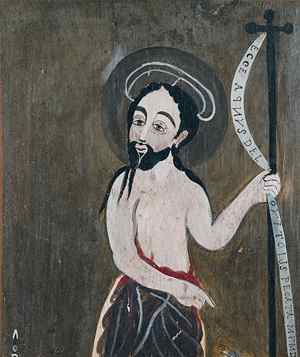
(above: Jose Rafaél Aragón, Saint John
the Baptist, natural pigments on wood panel. The Janis and Dennis Lyon
Collection)
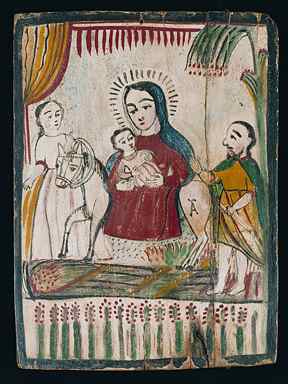
(above: Jose Rafaél Aragón, The Flight
into Egypt, natural pigments on wood panel. The Janis and Dennis Lyon
Collection)
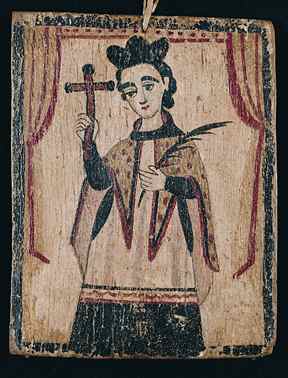
(above: Jose Rafaél Aragón, Saint Felix,
natural pigments on wood panel. The Janis and Dennis Lyon Collection)
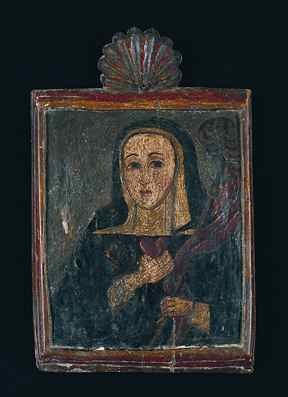
(above: The Eighteenth-Century Novice, Saint Gertrude,
oil paint on wood panel. The Janis and Dennis Lyon Collection)
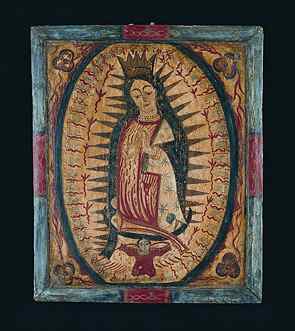
(above: Pedro Antonio Fresquís, Our Lady of Guadalupe,
natural pigments on wood panel. The Janis and Dennis Lyon Collection)
Wall texts from the exhibition
- Introductory panel
-
- Introduced to the Southwest by the Spanish, retablos flourished
as a devotional art form for roughly a century in colonial New Mexico.
Although the artists who made them, called santeros (saint-makers),
were largely self taught, they followed a code of symbols set forth by
the Catholic Church in their depictions of various holy figures. This use
of established symbols, or iconography, allowed for a largely illiterate
populace to identify each image, which proved instrumental to the conversion
of Indians to Christianity. These painted, wooden panels were venerated
in churches and private homes alike.
-
- Janis and Dennis Lyon have been serious connoisseurs and collectors
of New Mexican retablos for more than 30 years and have created
one of the world's finest private collections. Interested in coming as
close to the hands of these early painters as possible, they diligently
choose only those works with little or no restoration. Organized by Phoenix
Art Museum, this exhibition is made possible through the dedication and
generosity of Janis and Dennis Lyon, and the expertise of Dr. Charles Carrillo
and Father Thomas Steele.
-
-
- Second panel
-
- The santeros of New Mexico worked primarily with local, natural
supplies. Starting with a wooden panel, usually ponderosa pine, artists
applied a gesso made from baked gypsum and animal-hide glue or wheat flour
paste as a binding agent to hold the paint. Since few imported dyes were
available, artists made the majority of their water-based pigments made
from local clays, minerals, carbon soot, plants, barks, roots, and flowers,
which they then applied using homemade brushes. They used a piñon-sap
varnish for waterproofing.
-
- Burn marks are visible on several of the panels' bases. Specialists
and collectors long believed that such marks were caused by burning candles
left too close to the wooden objects. Recently research, however, indicates
that such markings were intentional. It is now believed that carbon removed
from the burned areas was used for medicinal purposes (for example, to
rub on an afflicted body part or stir into food or water), or possibly
preventative purposes (to toss into the air or a stream against natural
dangers, like fire, severe wind, or flood).
-
- New Mexican santeros worked on wooden panels, unlike their counterparts
in Mexico, who painted on tin. Tin, however, became more readily available
in New Mexico with the opening of the Santa Fe Trail in 1821, marking the
beginning of the end of the New Mexican retablos tradition. Traders
not only brought tin into the region, but also inexpensive, framed prints
of holy figures, which eventually forcing the santeros out of business.
-
- The Santeros (Saint-Makers)
-
- The Eighteenth-Century Novice (active c. 1780)
- An emigrant from southern New Spain (modern-day Mexico), this artist
was familiar with Spanish Baroque painting. He worked in oil paint, which
was rare for a New Mexican santero.
-
- Pedro Antonio Fresquís (1749 - after 1831)
- He was likely the earliest santero born in New Mexico and is believed
to have had apprentices or assistants who worked in a taller, or workshop.
-
- The Laguna Santero (active c. 1790 - 1815)
- Unknown by name, this santero is identified from a large altar screen
at the mission church at the Pueblo of Laguna. He is credited with making
more large-scale Colonial art than any other santero. His workshop also
produced devotional sculptures, called bultos.
-
- Molleno (active c. 1800 - 1830)
- A follower or apprentice of the Laguna Santero, healso created several
altar screens. The artist's name is not found in archival records and is
possibly a nickname preserved in the collective memory of the residents
of the Cañon Chimayó, north of Santa Fe.
-
- The A.J. Santero (active c. 1830 - 1850)
- An anonymous, educated santero identified by the initials "A.J."
found in the corner of a single retablo. He was not prolific, and there
are less than 50 retablos known by him.
-
- The Quill Pen Santero (active c. 1820 - 1850)
- This santero drew fine facial features with a quill pen, and was influenced
by Molleno. His use of what appear to be Pueblo Indian designs has led
some scholars to suggest that he was of American Indian heritage. His production
was limited, and his retablos are among the rarest in New Mexico.
-
- José Aragón (born c. 1781-89 - d. post - 1850)
- A prolific artist who made hundreds of retablos and bultos, Aragón
signed many of his works, unlike most santeros of his era. He was born
in Santa Fe and was an older brother to fellow santero, José Rafael
Aragón.
-
- The Christmas Santero (c. 1830s or 1840s)
- A short-lived sub-group of the Workshop of José Aragón,
recognized by the predominant use of bright red and green paints.
-
- The Arroyo Hondo Painter (active 1820s - 1840s)
- Named after an altar screen from the Church of Nuestra Señora
de Dolores de Arroyo Hondo, about 12 miles outside of Taos, this artist's
work is closely related to that of José Aragón. He was earlier
identified as the "Dot-Dash Painter" because of his use of decorative
elements. There is an extensive body of work attributed to this painter,
who also created bultos.
-
- José Rafael Aragón (born c. 1783-96 - 1862)
- He was arguably the finest and most talented santero of his era. A
highly prolific painter and sculptor, he created most of the altar screens
for the communities along the high road to Taos. Born and raised in Santa
Fe, he belonged to a network of artisan families of carpenters and woodworkers.
He resettled in Quemado in 1835.
-
- The Workshop (Taller) of José Rafael Aragón (c. 1830s-
c.1870s)
- José Rafael's son, Miguel, is believed to have followed in his
father's footsteps and worked at his father's workshop. Studies suggest
that followers continued to paint in the style of José Rafael after
his death.
-
- José Manuel Benavides (c. 1798 - post 1852)
- Previously identified as the anonymous Santo Niño Santero, Benavides
was a sculptor and painter who likely shared a workshop with José
Rafael Aragón.
Wall labels from the exhibition
Our Lady of Guadalupe
-
- Nuestra Señora de Guadalupe (Our Lady of Guadalupe),
is Mexico's and the Southwest's most beloved religious image and, not surprisingly,
is featured more often than any other holy figure in the Lyon Collection.
-
- From December 9 to 12, 1531, the Virgin Mary is believed to have appeared
four times to Juan Diego on the hill of Tepeyac, near Mexico City. She
requested that an abbey church be built on the site. When he asked for
a sign, she told him to gather roses in his tilma, or cloak. Later,
when he opened the tilma for the skeptical Spanish bishop, Fray
Juan de Zumárraga, the image of the Virgin was miraculously imprinted
on the cloth.
-
- Juan Diego was canonized in 2002, and his feast day is celebrated on
December 9. The feast for the Virgin of Guadalupe is December 12.
-
- 1) José Rafael Aragón (c. 1783-96 - 1862)
- Nuestra Señora de Guadalupe (Our Lady of Guadalupe)
- At the bottom is a baptismal font, likely in reference to the thousands
of Indians who sought baptism after hearing of Mary's appearance to San
Juan Diego.
-
- 2) Pedro Antonio Fresquís (1749 - after 1831)
- Nuestra Señora de Guadalupe (Our Lady of Guadalupe)
-
- 3) Molleno (active c. 1800 - 1830)
- Nuestra Señora de Guadalupe (Our Lady of Guadalupe)
-
- 4) Pedro Antonio Fresquís (1749 - after 1831)
- Nuestra Señora de Guadalupe (Our Lady of Guadalupe)
-
- 5) Workshop of José Aragón (c. 1820s - 1840s)
- Nuestra Señora de Guadalupe (Our Lady of Guadalupe)
- New Mexican santeros made this type of retablo to relate to the Virgin's
four apparitions to San Juan Diego. In the lower right corner, he reveals
the miraculous image. The awkward shape of the mandorla, or halo surrounding
the Virgin, may represent San Juan Diego's tilma, or cloak.
-
- 6) The Laguna Santero (active c. 1790 - 1815)
- Nuestra Señora de Guadalupe (Our Lady of Guadalupe)
-
- 7) The Arroyo Hondo Painter (active 1820s - 1840s)
- Nuestra Señora de Guadalupe (Our Lady of Guadalupe)
-
-
- Holy Family and Christ
-
- 1) The Workshop (Taller) of José Rafael Aragón (c. 1830s
- 1860)
- El Santo Niño de Atocha (The Holy Child of Atocha)
-
- 2) José Rafael Aragón (c. 1783-96 - 1862)
- La Huida al Egipto (The Flight into Egypt)
- Led by a wingless angel, the family of Christ flees persecution from
King Herod's soldiers.
-
- 3) José Aragón (c. 1781-89 - after 1850)
- Jesús con la Cruz a Cuestas (Jesus Bears the Cross on His
Back)
-
- 4) José Rafael Aragón (c. 1783-96 - 1862)
- La Huida al Egipto (The Flight into Egypt)
-
- 5) The Arroyo Hondo Painter (active 1820s - 1840s)
- Jesús con la Cruz a Cuestas (Jesus Bears the Cross on His
Back)
- Christ is shown with multiple wounds of the Passion (Latin passio,
"suffering"), including a bloody mark on his left cheek, known
in New Mexico as El Beso de Judas, (The Kiss of Judas).
-
- 6) The Christmas Santero (active c. 1830s or 1840s)
- Cristo Crucificado y Calvario (Christ Crucified and Calvary)
-
- 7) Pedro Antonio Fresquís (1749 - after 1831)
- Cristo Crucificado (Christ Crucified)
-
- 8) José Rafael Aragón (c. 1783-96 - 1862)
- M 3) Las Cinco Llagas (The Five Wounds)
- This image symbolizes the five wounds Christ suffered on the cross:
two for the hands, two for the feet, and the spear to the side. The three
wedges inside the heart likely represent the nails used in the Crucifixion.
-
- 9) The Christmas Santero (active c. 1830s or 1840s)
- La Santa Cruz con San Juan Evangelista y Nuestra Señora de
Delores (The Holy Cross with Saint John the Evangelist and Our Lady of
Sorrows);
- or, La Cruz Vestida con José de Arimatea (or Nicodemos)
y María Magdalena (The Vested Cross with Joseph of Arimathea [or
Nicodemus] and Mary Magdalen);
- or, La Santísima Cruz y El Santo Lino con Figuras Dolientes
(The Most Holy Cross and the Holy Cloth with Mourning Figures)
-
- 10) Pedro Antonio Fresquís (1749 - after 1831)
- Cristo Crucificado (Christ Crucified)
- The skull at the base of the cross symbolizes Adam, the first man,
believed to be the original sinner. The blood from the crucified Christ
is intended to cleanse mankind of its sins. People prayed to images of
Christ so that he may offer supernatural gifts: salvation of the world,
peace, pardon of sin, bearing of sufferings, piety, or a peaceful death.
- Joseph and Mary
-
- 1) The Laguna Santero (active c. 1790 - 1815)
- San José (Saint Joseph)
-
- 2) Pedro Antonio Fresquís (1749 - after 1831)
- San José (Saint Joseph)
- Joseph holds hollyhocks, called "the rod of Saint Joseph"
in New Mexico.
-
- 3) The Quill Pen Santero (active c. 1820 - 1850)
- San José (Saint Joseph)
-
- 4) José Aragón (c. 1781-89 - after 1850)
- San José (Saint Joseph)
-
- 5) José Rafael Aragón (c. 1783-96 - 1862)
- Nuestra Señora Esposa de José (Our Lady Spouse of
Joseph)
- This unique depiction of Mary is likely one of a pair of images, the
other depicting Joseph.
-
- 6) José Manuel Benavides (c. 1798 - after 1852)
- Señor San José Esposo de María (Lord Saint
Joseph Spouse of Mary)
- Joseph is the patron of the universal Church, fathers, families, orphans,
travelers, carpenters and workers. To aid in selling a house, people frequently
bury statues of Saint Joseph in the yard. Benavides likely copied this
image from an engraving of a sculptural bust of Joseph on a pedestal.
-
- 7) The Quill Pen Santero (active c. 1820 - 1850)
- San José (Saint Joseph)
-
- 8) The A.J. Santero (active c. 1830 - 1850)
- San José (Saint Joseph)
-
-
- Mary and the Holy Trinity
-
- 1) José Rafael Aragón (c. 1783-96 - 1862)
- El Alma de María (The Soul of Mary); or, La Santísima
Trinidad con María (The Most Holy
- Trinity with Mary)
- Originally identified as representing the soul of Mary, specialists
now believed that this retablo represents the Most Holy Trinity with Mary:
the baton represents God the Father's scepter of omnipotence, and the dove
represents the Holy Spirit that visually connects the Christ Child with
the symbol of God.
-
- 2) José Rafael Aragón (c. 1783-96 - 1862)
- La Virgen de los Reyes Católicos y La Santísima Trinidad
(The Virgin of the Catholic Kings and the Most Holy Trinity)
- This retablo may be understood as a form of political propaganda. On
Mary's right is King Ferdinand VII of Spain, and to her left is the Archbishop
Saint Leander of Seville, or possibly his younger brother Saint Isidro.
Aragón showed the king in a favorable light by associating him with
holy figures.
-
-
- Variations of Our Lady
-
- 1) Workshop of the Laguna Santero (c. 1800 - 1815)
- Nuestra Señora de San Juan de los Lagos (Our Lady of Saint
John of the Lakes)
- Standing on a pedestal and flanked by a pair of candles, this image
was based on a shrine at San Juan de los Lagos in Mexico.
-
- 2) Pedro Antonio Fresquís (1749 - after 1831)
- Nuestra Señora de los Dolores (Our Lady of Sorrows)
-
- 3) The Workshop (Taller) of José Rafael Aragón (c. 1830s
- 1860)
- Nuestra Señora de la Cueva Santa (Our Lady of the Sacred
Cave)
-
- 4) Workshop of José Aragón (c. 1820s - 1840s)
- Nuestra Señora de Dolores (Our Lady of Sorrows)
- The dagger in Mary's heart powerfully symbolizes severe grief. Mary's
sorrow over Jesus' death makes her patron of strength in suffering, compassion
for others, and help in childbirth and with children.
-
- 5) The Arroyo Hondo Painter (active 1820s - 1840s)
- Nuestra Señora del Carmen (Our Lady of Mount Carmel)
- Worshippers believe Our Lady of Mount Carmel is an intercessor for
souls in Purgatory, which appear at the bottom of the panel. The crack
on the left side was repaired using native techniques.
-
- 6) Pedro Antonio Fresquís (1749 - after 1831)
- Nuestra Señora de la Manga (Our Lady of the Sleeve)
- Only two known examples of this subject exist from New Mexico, both
by Fresquís. The use of crosshatching lines suggests the artist
copied the image from an engraving.
-
- 7) José Rafael Aragón (c. 1783-96 - 1862)
- Nuestra Señora de Dolores (Our Lady of Sorrows)
- The three small holes at the bottom edge of the Virgin's gown indicate
that an object or objects were once attached to the bottom of the retablo.
-
- 8) Workshop of José Aragón (c. 1820s - 1840s)
- Nuestra Señora Refugio de Pecadores (Our Lady, Refuge of
Sinners)
-
- 9) José Aragón (c. 1781-89 - after 1850)
- Nuestra Señora de Carmen (Our Lady of Mount Carmel)
-
- 10) Molleno (active c. 1800 - 1830)
- Nuestra Señora de San Juan de los Lagos (Our Lady of Saint
John of the Lakes)
-
- 11) Workshop (Taller) of Fresquís (c. 1800 - 1830s)
- Nuestra Señora de Dolores (Our Lady of Sorrows)
-
- 12) The Arroyo Hondo Painter (active 1820s - 1840s)
- Nuestra Señora de la Purísima Concepción (Our
Lady of Immaculate Conception)
-
- 13) The Arroyo Hondo Painter (active 1820s - 1840s)
- Nuestra Señora de Dolores (Our Lady of Sorrows)
-
- 14) Workshop (Taller) of Fresquís (c. 1800 - 1830s)
- Nuestra Señora del Rosario (Our Lady of the Rosary)
-
- 15) José Rafael Aragón (c. 1783-96 - 1862)
- Nuestra Señora de Merced (Our Lady of Mercy)
-
- 16) Pedro Antonio Fresquís (1749 - after 1831)
- Nuestra Señora del Rosario (Our Lady of the Rosary)
-
- 17) José Rafael Aragón (c. 1783-96 - 1862)
- Nuestra Señora del Carmen (Our Lady of Mount Carmel)
-
- 18) Pedro Antonio Fresquís (1749 - after 1831)
- Nuestra Señora del Carmen (Our Lady of Mount Carmel)
- Both the Virgin and the Christ Child hold a small, red, rectangular
scapular, pieces of woolen cloth worn as a symbol of devotion.
- Saints
-
- The saints in the next three sections on this wall are arranged in
roughly chronological order of their life dates, ranging from the 1st to
the 16th century.
-
- 1) José Rafael Aragón (c. 1783-96 - 1862)
- San Juan Bautista (Saint John the Baptist)
- Outside of altar screens for churches, this is one of the largest known
retablos by Aragón. Saint John is shown in a slightly turned, contrapposto
pose, which is common in Baroque sculpture. However, the artist lacked
knowledge in rendering perspective and John's legs appear as if crossed.
-
- 2) The Arroyo Hondo Painter (active 1820s - 1840s)
- San Acacio (Saint Acacius of Mount Ararat)
- Although Saint Acacius was a 3rd century Roman centurion, the artist
dressed him as a Spanish soldier of the early 19th century.
-
- 3) The Workshop (Taller) of José Rafael Aragón (c. 1830s
- 1860)
- San Acacio (Saint Acacius of Mount Ararat)
-
- 4) José Rafael Aragón (c. 1783-96 - 1862)
- San Acacio (Saint Acacius of Mount Ararat)
-
- 5) José Rafael Aragón (c. 1783-96 -1862)
- San Nicolás de Myra/Bari (Saint Nicholas of Myra/Bari)
- A patron to sailors, referenced by the clouds above his head, Saint
Nicholas was also known to be generous. He once gave an anonymous gift
of gold for the dowries of three sisters, thus saving them from prostitution.
He died in 342, and in 1087 his bones were robbed from Myra, in modern-day
Turkey, and taken to Bari, Italy. They were eventually carried throughout
Europe, where he became a popular saint. The Dutch changed his name to
Sint Klaes, while the English called him Santa Claus.
-
- 6) José Rafael Aragón (c. 1783-96 - 1862)
- San Félix (Saint Felix)
-
- 7) Workshop (Taller) of Fresquís (c. 1800 - 1830s)
- San Gerónimo (Saint Jerome)
-
- 8) José Rafael Aragón (c. 1783-96 - 1862)
- San Casiano de Imola (Saint Cassian of Imola)
-
- 9) José Rafael Aragón (c. 1783-96 - 1862)
- San Isidro Labrador (Saint Isidore the Worker)
- Saint Isidore is the patron saint of ranchers, farmers, and good harvests.
He protects against locusts, earthquakes, bad weather and bad neighbors.
New Mexican people believed that Isidore, a Spaniard, lived with his wife,
Santa Maria, near the Rio Grande.
-
- 10) José Rafael Aragón (c. 1783-96 - 1862)
- San Isidro Labrador (Saint Isidore the Worker)
-
- 11) Pedro Antonio Fresquís (1749 - after 1831)
- San Norberto (Saint Norbert)
-
- 12) The Arroyo Hondo Painter (active 1820s - 1840s)
- San Isidro Labrador (Saint Isidore the Worker)
- Saint Isidore stands to the side of two oxen that pull a single-handled
plow, an ancient implement used by New Mexicans as late as the turn of
the 20th century.
-
Saints
-
- 1) Workshop of José Aragón (c. 1820s - 1840s)
- Santa Rosalía de Palermo (Santa Rosalia of Palermo)
-
- 2) The A.J. Santero (active c. 1830 - 1850)
- Santa Rosalía de Palermo (Saint Rosalie of Palermo)
-
- 3) The A.J. Santero (active c. 1830 - 1850)
- San Francisco de Asís (Saint Francis of Assisi)
- Saint Francis of Assisi created three religious orders: the first for
priests and brothers, the second for nuns and the third for married or
single men and women. Aimed at converting the native population, the Franciscan
Order in New Mexico dates back to 1540 and the expeditions of Coronado.
They maintained several Franciscan missions around the Santa Fe region
in the 19th century.
-
- 4) Pedro Antonio Fresquís (1749 - after 1831)
- San Antonio de Padua (Saint Anthony of Padua)
-
- 5) The Quill Pen Santero (active c. 1820 - 1850)
- San Antonio de Padua (Saint Anthony of Padua)
- Born in Lisbon, Portugal, in 1195, Saint Anthony was a university-educated
Augustinian, ordained around 1220. Saint Francis gave Anthony a mandate
to teach, and his mission sent him throughout Italy and into France and
Spain. He died in 1231 in the outskirts of Padua.
-
- 6) José Aragón (c. 1781-89 - after 1850)
- San Antonio de Padua (Saint Anthony of Padua)
-
- 7) Workshop (Taller) of Fresquís (c. 1800 - 1830s)
- San Antonio de Padua (Saint Anthony of Padua)
-
- 8) José Rafael Aragón (c. 1783-96 - 1862)
- San Antonio de Padua (Saint Anthony of Padua)
- This retablo stands out as one of the most accomplished works by Aragón.
Saint Anthony kneels as he exchanges hearts with the Christ Child, powerful
depicting their spiritual union. A basket of hearts on the base of the
altar table symbolizes the souls of believers.
-
- 9) Pedro Antonio Fresquís (1749 - after 1831)
- San Antonio de Padua (Saint Anthony of Padua)
-
- 10) The Laguna Santero (active c. 1790 - 1815)





